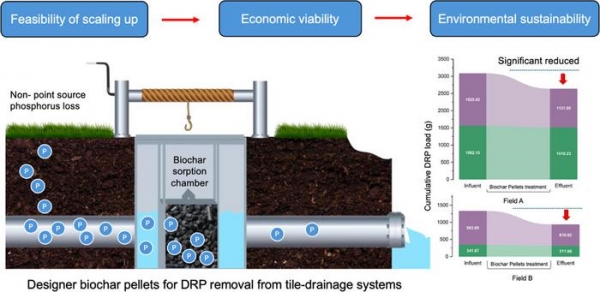What if farmers could not only prevent excess phosphorus from polluting downstream waterways, but also recycle that nutrient as a slow-release fertilizer, all without spending a lot of money? In a first-of-its-kind field study, University of Illinois Urbana-Champaign researchers show it’s possible and economical.
“Phosphorus removal structures have been developed to capture dissolved phosphorus from tile drainage systems, but current phosphorus sorption materials are either inefficient or they are industrial waste products that aren’t easy to dispose of. This motivated us to develop an eco-friendly and acceptable material to remove phosphorus from tile drainage systems,” said study author Hongxu Zhou, who completed the study as a doctoral student in the Department of Agricultural and Biological Engineering (ABE), part of the College of Agricultural, Consumer and Environmental Sciences and The Grainger College of Engineering at U. of I.
Zhou and his co-authors used sawdust and lime sludge, byproducts from milling and drinking water treatment plants, respectively. They mixed the two ingredients, formed the mixture into pellets, and slow-burned them under low-oxygen conditions to create a “designer” biochar with significantly higher phosphorus-binding capacity compared to lime sludge or biochar alone. Importantly, once these pellets bind all the phosphorus they can hold, they can be spread onto fields where the captured nutrient is slowly released over time.
Read more at University of Illinois College of Agricultural, Consumer and Environmental Sciences
Image: University of Illinois Urbana-Champaign researchers find designer biochar can inexpensively and sustainably remove up to 41% of dissolved phosphorus in farm drainage water. (Credit: University of Illinois Urbana-Champaign)
Sci/Tech Agriculture Top Stories
